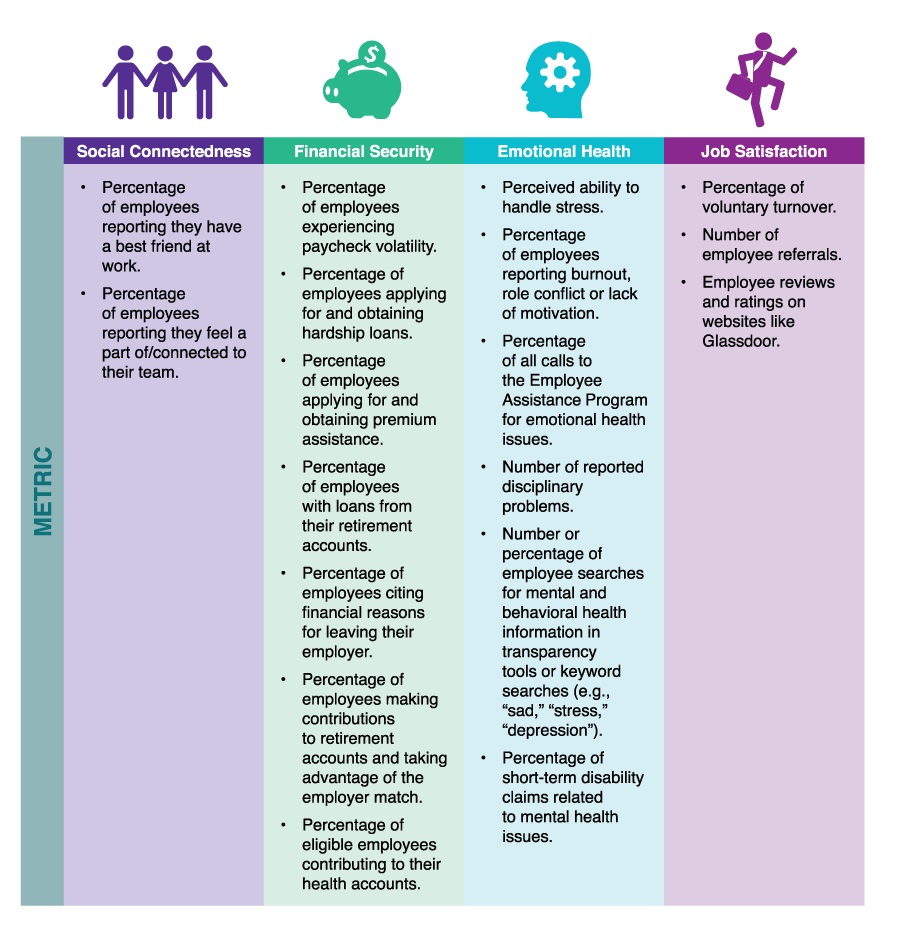January 09, 2020
Using health assessments and biometric screenings to evaluate the physical health of employees has been a critical component of wellness programs over the last several decades. These assessment tools have been used to demonstrate the needs for programs, steer employees to relevant programs, and evaluate health improvement over time. However, as employers broaden their wellness strategies to include other dimensions of well-being (e.g. financial, emotional and social well-being), health assessments in their traditional form may not provide needed insights. To capture data on employee well-being beyond physical health, employers have three options:
- Add well-being questions to existing employee surveys;
- Use a validated well-being assessment; and
- Leverage data from internal and external sources to serve as proxy measures.
Each of these approaches has considerations associated with it, as outlined below. The decision to use a particular method will depend on a number of factors, including an employer’s overall goals, budget and timeline, as well as their philosophy about conducting an annual employee survey. Key questions employers may ask before proceeding with a particular assessment method include:

- Are we going to use the information to show a need for a new initiative or to justify an existing one?
- Are we going to use the information to steer employees to specific programs?
- For which dimensions of well-being are we interested in obtaining data?
- Are we willing and able to work with a vendor partner to deploy a survey?
- Are we willing and able to work with other departments within the organization to obtain data?
- What is our timeline for obtaining data?
Include Well-being Questions in Existing Employee Surveys
Employers with an existing health assessment, engagement or satisfaction survey can add questions to glean information about employee well-being. Adding questions to existing surveys may be the least disruptive to current processes or vendor arrangements, while providing information necessary to understand employees’ needs. To choose the particular survey to add questions to, employers should consider participation rates, the design of the program and the need for validated data. A summary of considerations related to this method of data collection is included in the chart below.
Considerations
| Offers information on individual dimensions of well-being (e.g., physical, emotional, financial, etc.). | YES |
| Provides a validated and/or directed association between the questions and well-being dimensions | Depends on the question(s) added. |
| Provides employees with personalized feedback, and could be leveraged to steer employees to specific programs. | Depends on the survey. Health assessments provide employees with feedback; engagement or satisfaction surveys typically do not. |
| Provides a total well-being score. | NO |
| Requires employee engagement. | YES |
| Requires vendor support | YES |
A number of employers have added questions to their existing surveys. Examples of questions that have been added to health assessments about employee financial security include:
- Do you have enough money to meet your basic needs?
- Do you have a budget?
- Are you on track to meet your financial goals?
Examples of well-being questions employers have added to engagement surveys include:
- At work I’m encouraged to pursue healthy habits.
- My immediate manager supports my efforts to balance work/life.
- When I’m not working I have enough energy to engage with friends and family.
- I am able to focus on the present moment.
- I am able to effectively cope with the stress of my job.
- I have friends on the job.
- I am currently attaining my financial goals.
- I have the physical energy to do what I want to do on a daily basis.
Use a Validated Well-being Assessment
In lieu of a health assessment, employers can use a well-being assessment that examines multiple dimensions of employees’ lives and provides insights into what’s helping or hurting their overall well-being. Employers considering this approach must weight many of the same issues as those mentioned in the health assessment section above. But a well-being assessment may have the added benefit of providing a total well-being score at the individual and/or population level. Additional considerations related to this method of data collection at included in the chart below.
Considerations
| Offers information on individual well-being dimensions. | YES |
| Provides a validated and/or direct association between the question and the well-being dimension. | YES Employers should verify with their vendor |
| Provides employees with personalized feedback and could be leveraged to steer employees to specific programs. | YES |
| Provides a total well-being score. | YES |
| Requires employee engagement. | YES |
| Requires partnership with a vendor | YES |
Leverage Data From Internal and External Sources to Serve as Proxy Measures
Employers who do not survey employees, who do not wish to add questions to existing surveys, or who need data more immediately, can gain useful insights on employee well-being by examining data that they already have on file. Relevant data may come from Human Resource Information Systems (HRIS), health an dwell-being program vendors, or sources such as Glassdoor, a website that provides transparent employee reviews and ratings. This data can serve as proxy measures for survey questions. Leveraging proxy measures offers the benefit of providing more immediate data, without the time and expense of surveys; and it doesn’t rely on employees participating in the surveys. However, proxy data may not indicate a clear relationship. Examples of metrics that may provide insights into four dimensions of well-being are included in Table 1. Additional considerations related to this method of data collection are included in the charts below.
Considerations
| Offers information on individual well-being dimensions. | YES |
| Provides a validated and/or direct association between the question and well-being dimension. | NO |
| Provides employees with personalized feedback. | NO |
| Provides a total well-being score. | NO |
| Requires employee engagement. | NO |
| Requires partnership with a vendor. | NO |
Examples of Metrics that Provide Well-being Insights
The metrics below can provide information on employee well-being. Employers interested in using these metrics are encouraged to examine several years of data and look at trends over time. For example, the percentage of voluntary turnover for one year may not be a good proxy measure for job satisfaction. However, looking at this metric over several years – and potentially comparing it to industry benchmarks – may provide better insights into employee satisfaction an company culture. In addition, employers may need to piece together different data points to make any inferences about employee well-being. In finding a good proxy to assess financial security, for example, the percentage of employees making contributions to their retirement accounts and taking advantage of the employer match may not be sufficient, unless combined with other telling data.

More Topics
Articles & Guides
This content is for members only. Already a member?
Login
![]()
